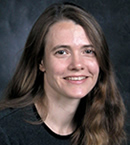|
Research
|
Correct cell cycle regulation is essential to prevent carcinogenesis. Mis-regulation of the cell cycle can allow uncontrolled growth and division and can also cause genome instability. Resulting genetic changes may further promote proliferation and metastisis.
Cell Cycle regulation governs genome replication, packaging, and gene expression. The cell cycle itself is controlled by the cyclin dependent kinase Cdc2 (also called Cdk1). We are using the simple eukaryote S. pombe as a model system to determine how cell cycle controls regulate genome structure, DNA replication, and gene expression. High throughput approaches and S. pombe microarrays allow us to ask questions genome-wide. Current projects can be divided into three subjects areas: 1) Cell Cycle Transcription Circuits, 2) Regulation of DNA Replication Control, and 3) Regulation of Gene Expression in the Meiotic Cell Cycle.
1) Cell Cycle Transcription Circuits:
Microarrays were used to measure gene expression through the cell cycle of S. pombe (fission yeast), and 750 cell cycle regulated genes were identified. These were placed into clusters. Tentative assignments of transcription factors were made to the major clusters (Oliva et al, PLoS Biology, 2005). We are continuing to explore the circuitry of the S. pombe cell cycle transcriptional network. This includes defining the contributions of the major cell cycle transcription factors MBF, Forkhead, and Ace2, understanding how each major cluster of genes expressed in mitosis is controlled, how the clusters are co-ordinated with one another, and how combinatorial control by different transcription factor families is used to achieve an efficient cell cycle transcription program.
Relevance: S. pombe is an excellent choice for the kind of comprehensive and global analysis proposed here. It has been and continues to be a major tool for study of the eukaryotic cell cycle and therefore will provide further insights for understanding human cell cycle regulation and how that program is altered in disease and oncogenesis.
Want to see the cell cycle transcript profile for your favorite gene?
Please visit http://www.redgreengene.com/oliva_plos_2005/index.html where you can access all the datasets published in Oliva et al, 2005 and you can view data gene by gene.
2) Regulation of DNA Replication Control:
One of the most important things that Cdc2 does is to coordinate DNA replication with cell growth and division. To achieve this, Cdc2 has two seemingly opposite functions. First, Cdc2 activates initiation of DNA replication. Second, Cdc2 inhigits re-replication of the newly replicated DNA. This inhibition is maintained throughout S-phase and G2 and is essential for genome stability.
We discovered that Cdc2 interacts with a fission yeast ORC homolog (named Orp2 or Orc2). ORC (Origin Recognition Complex) is the platform that recruits and organizes replication initiation machinery on DNA in eukaryotes. ORC-Cdc2 interaction suggests that Cdc2 acts directly at individual origins of replication throughout the genome to control DNA replication (Leatherwood et al, Nature, 1996).
Cdc2 phosphorylation of replication factors including Orp2 and Cdc18 (Cdc6) are both mechanisms to ensure once-per-cell cycle control of DNA replication (Vas et al, MCB, 2001). We have found that when this control is disrupted, re-replication begins at origins genome-wide and is surprisingly independent of the DNA damage and replication checkpoint pathways (Mickle et al, BMC Mol. Biology, 2007, ref. #2).
We are continuing to investigate the specific types of genome instability generated by loss of cell cycle control of DNA replication, and we are continuing to study how genome organization and chromatin context affect DNA replication timing within S-phase (Zapulla, et al, Curr Biol.2002, and Mickle et al, BMC Mol. Biology, 2007, ref. #1). Our current studies are in collaboration with Dr. Joel Huberman, Rosewell Park Cancer Center.
3) Regulation of Gene Expression in the Meiotic Cell Cycle:
We discovered an extensive program of regulated splicing during S. pombe meiosis (Averbeck et al, 2005). Our ongoing studies in collaboration with Dr. Jo Ann Wise, Case Western Reserve, suggest that mRNA processing provides a key regulatory step for control of gene expression during the specialized meiotic cell cycle.
A Facility for Yeast Microarrays:
Want to know what transcripts or elevated in your favorite mutant?
The resources of our microarray facility are available at cost to any not for profit research lab worldwide . We have spotted DNA microarrays for S. pombe and S. cerevisiae and will gladly process cell pellets to purify RNA, make labeled sample, hybridize to arrays, grid images and make data available along with analysis tools. Similar sample processing, hybridization, and data collection can also be carried out in our facility for high density microarray platforms from Agilent and Affymetrix. Please e-mail Janet Leatherwood ( mailto:jleatherwood@ms.cc.sunysb.edu">jleatherwood@ms.cc.sunysb.edu, or Bruce Futcher (bfutcher@ms.cc.sunysb.edu) for more information.
|


